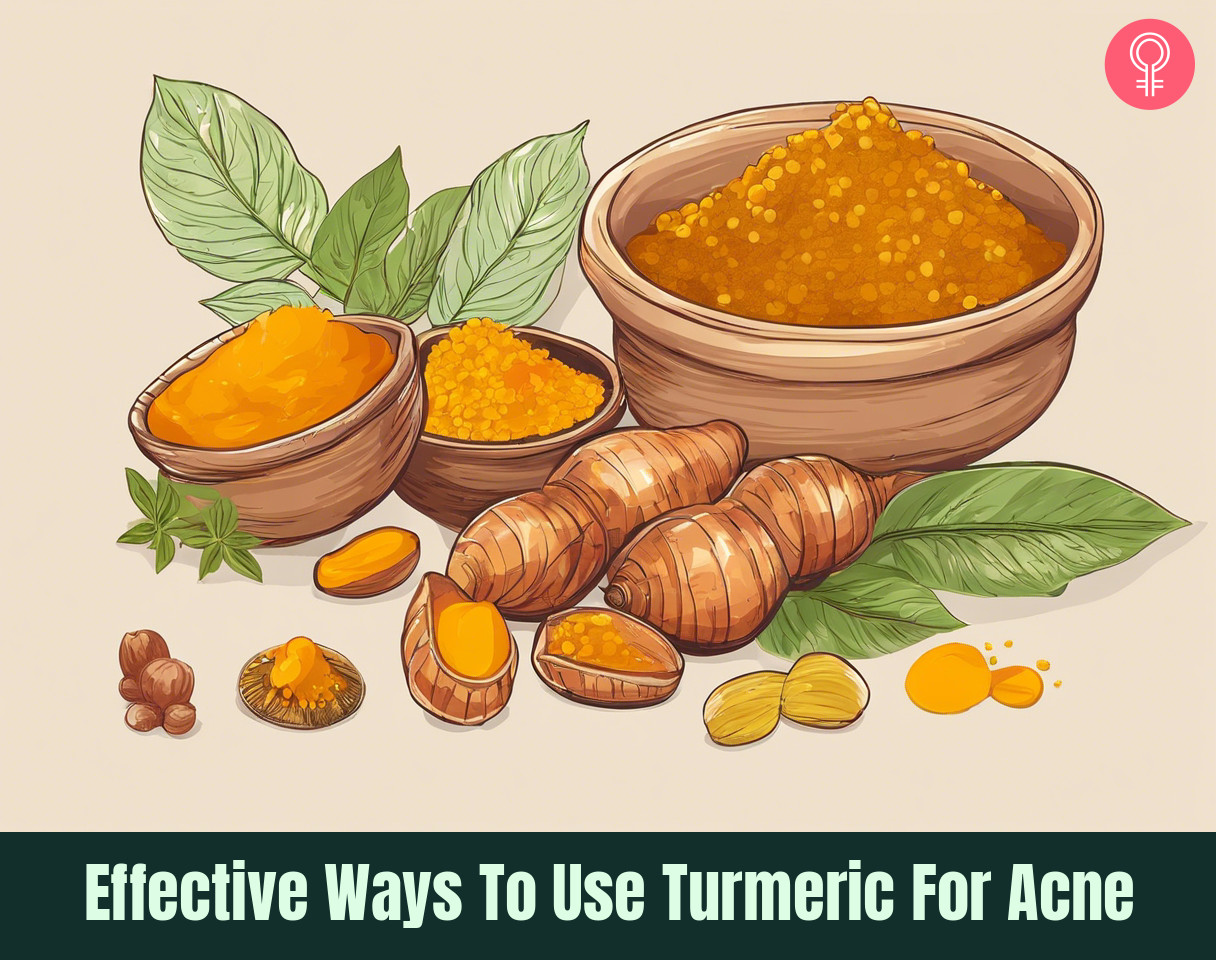Turmeric is a medicinal flavor extensively utilized in DIY skin care recipes. Many thanks to its anti-inflammatory homes, people commonly make use of turmeric for acne monitoring, and you will certainly additionally locate it in skin care items. While there is restricted evidence to show the effectiveness of turmeric for acne, its anti-inflammatory buildings and healing impacts make it a useful active ingredient in acne management ( 1 ), ( 2 ). It may additionally decrease acne marks and is suitable for sensitive skin. Maintain reviewing to comprehend just how turmeric extract may help minimize the occasional breakouts and ways to use it.
In This Article
Turmeric For Acne And Pimples: What Are The Benefits?
1. It Inhibits Acne-causing Bacteria
Curcumin i X A bright yellow pigment found in turmeric that helps manage inflammatory conditions, anxiety, and arthritis. has antibacterial properties. In a test-tube research study done on pig skin, curcumin (together with Lauric acid) was found to prevent the growth of P. Acnes, microorganisms that cause inflammatory acne ( 3 ).
2. It May Reduce Inflammation
Curcumin has anti-inflammatory and antioxidant properties. A research suggests that when taken orally or applied, curcumin might help reduce inflammatory acne and other types of swelling to maintain your skin healthy ( 2 ).
Related: Skin Inflammation: Causes, Symptoms, Diagnosis, And Treatment
3. It May Help Improve Dark Spots Caused By Acne
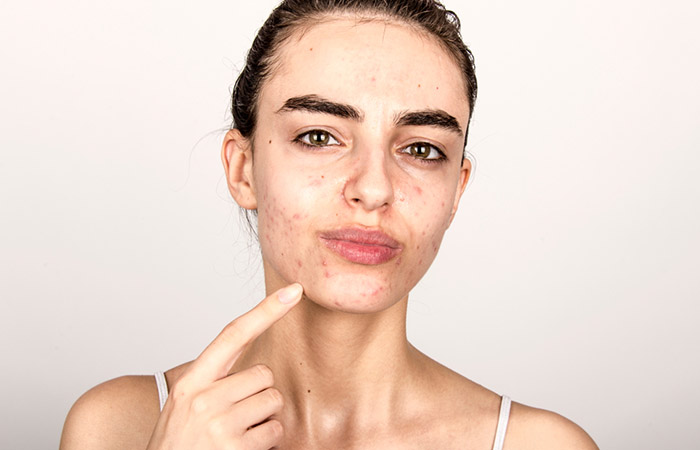
A study found that a cream containing turmeric extracts helped with skin tone improvement and acne hyperpigmentation ( 4 ). Hence, it may help in fading dark spots, left behind by stubborn acne, and blemish control.
Turmeric has other health and skin benefits, such as:
- It decreases aging by postponing the start of age-related wellness problems by preventing inflammation caused by NF-kappaB (a protein complicated that adds to immunity and swelling) ( 5 ).
- It prevents skin damage caused by UV radiation. A study done on hairless mice found that turmeric extracts could prevent wrinkles and loss of elasticity caused by UVB exposure and improve skin thickness ( 6 ).
Since you understand just how turmeric can heal acne aid in pimple avoidance, and pimples and maintain your skin healthy, scroll down to figure out ways to make use of turmeric for acne and acnes.
Quick TipCurcumin, in turmeric, is known to help with anxiety ( 1 ), suggesting that it may help improve mental health issues that may arise due to acne or aggravate the condition.
How To Use Turmeric For Acne And Pimples
Topical Application
1. Turmeric And Honey
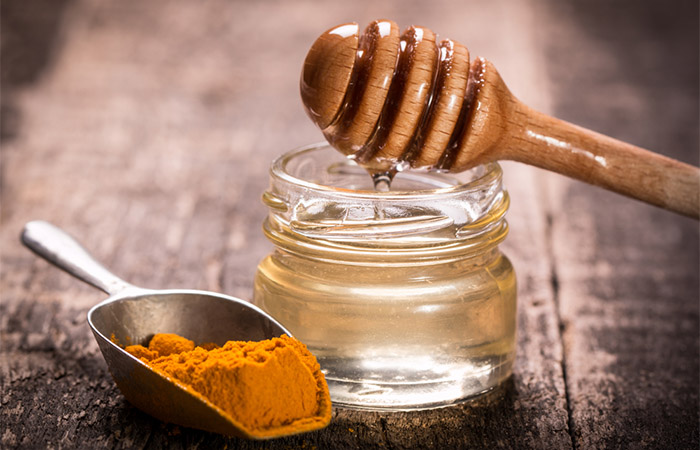
Test-tube studies have found that honey can inhibit the growth of Propionibacterium acnes and S. aureus ( 7 ). Along with turmeric, honey can help kill the acne-causing bacteria. Honey being non-comedogenic is often recommended for acne management.
Ingredients
- 1 teaspoon turmeric
- 1/2 teaspoon raw honey
Procedure
- Mix honey and turmeric to get a thick paste.
- Use this paste on spots for acne treatment or apply it all over your face (increase quantities accordingly).
- Leave it on for 10-12 minutes.
- Rinse with water.
How Often You Should Do This
- Do this once every day.
2. Turmeric And Yogurt
Yogurt may not help kill the acne-causing bacteria, but it contains lactic acid. It may have a mild exfoliating effect on your skin, and along with turmeric, this might accelerate healing.
Ingredients
- 2 tablespoons yogurt (curd)
- 1/2 teaspoon turmeric
Procedure
- Blend the turmeric well with the yogurt and apply the mixture to the affected area.
- Rinse after 15 minutes.
How Often You Should Do This
- Use this three to four times a week.
Siphosami, a YouTuber, who attempted a turmeric face mask for seven days explained her experience. She made use of a mix of turmeric, yogurt, lemon, and honey to clear her skin of acne and acnes. She specified that, "On day 1 my skin was horrible and I had big acnes there and right here however on day 5 you men can see the distinction ( i ).” She further added, “It definitely works. I’ve seen the changes myself.”
3. Aloe Vera And Turmeric
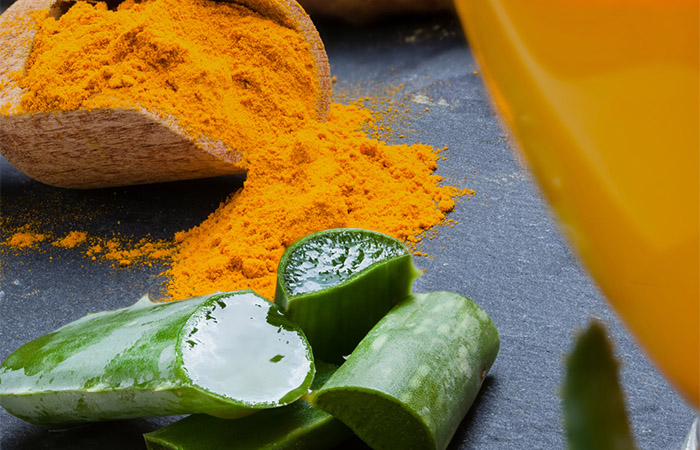
Aloe vera can help heal acne faster ( 8 ). This combination may foster healing and help maintain your skin health.
Ingredients
Procedure
- Extract fresh aloe vera gel from the center of an aloe vera leaf.
- Add the turmeric powder to this gel and mix well.
- Apply the mixture to the acne-affected area and let it sit for 10 minutes.
- Rinse it off using regular water.
How Often You Should Do This
- You can repeat this every day or every alternate day.
4. Turmeric And Baking Soda
It is not recommended to apply baking soda on your face or skin. Additionally, there is no study recommending its efficiency for acne. However, it is a widely used remedy. Anecdotal evidence states that baking soda can dry out acne and help in healing it.
Ingredients
- ½ teaspoon turmeric powder
- A pinch of baking soda
- Water (to make a paste)
Procedure
- Mix baking soda, turmeric powder, and water to make a paste.
- Use a Q-tip to apply the mixture on the acne (as a spot treatment).
- Leave it to dry and then wash off.
How Often You Should Do This
- Do this not more than two times a week.
5. Lemon And Turmeric
Lemon is stated to have an astringent i X A compound or chemical representative that aids reduce tissues and dry up skin secretions to tighten up pores and cleanse the skin. result on the skin, which might aid in drying out the acne sores. Given that lemon juice can be harsh on the skin, avoid utilizing it pure. It additionally makes the skin photosensitive i X Conscious light or electro-magnetic or any kind of other radiation that causes a threat of establishing sunburn., so make sure you apply sun block before you step out.
Ingredients
- 1 tablespoon lemon juice (dilute it with a tablespoon of water)
- 1/2 teaspoon turmeric
Procedure
- Mix the ingredients and apply the mixture to the affected area.
- Keep it on for 10-12 minutes and then wash it off.
How Often You Should Do This
- Do this once every day for the best results.
6. Besan And Turmeric
Besan or gram flour assists in skin cleaning and skin peeling. It helps to reduce excess sebum and is thought about a great alternative for healing acne and acnes ( 9 ).
Ingredients
- 1 teaspoon turmeric
- 2 teaspoons besan (gram flour)
- 2-3 teaspoons rose water or yogurt
Procedure
- Mix the turmeric, gram flour, and rose water well until you get a thick paste.
- Apply the paste on a clean face.
- Leave it on for 15-20 minutes and wash it off.
How Often You Should Do This
- Repeat this two times a week.
7. Sandalwood And Turmeric
A blend of sandalwood oil and salicylic acid was found to improve acne in mice studies ( 10 ). However, more research is needed to conclude the efficacy of sandalwood in healing acne.
Ingredients
- 2 tablespoons sandalwood powder or 2-3 drops of sandalwood oil
- 1/2 teaspoon turmeric
- Rosewater
Procedure
- Mix the sandalwood powder, turmeric, and rose water in a bowl.
- Apply the paste on your pimples.
- Leave it on for about 15-20 minutes and then wash it off using lukewarm water.
How Often You Should Do This
- Use this mask for acne and pimples two times a week.
8. Milk And Turmeric
Milk consists of lactic acid that has a moderate scrubing effect. It may likewise give skin irritation relief due to its calming residential properties. This blend can maintain your skin acne-free and make it soft.
Ingredients
- 1/2 teaspoon turmeric
- 2 tablespoons milk
- Cotton ball
Procedure
- Mix the turmeric in the milk and apply it to the affected area using the cotton ball.
- Leave it on for 10 minutes and then rinse it off.
How Often You Should Do This
- Use this every alternate day.
9. Neem Leaves And Turmeric
Neem leaves have antibacterial effects against P. acnes and can help you manage acne ( 11 ).
Ingredients
- 10-12 neem leaves
- 1/4 teaspoon turmeric
Procedure
- Boil the neem leaves and grind them.
- Add the turmeric powder to this paste and mix well.
- Apply the mixture to the acne and let the pack dry naturally for about 10 minutes.
- Rinse with cool water.
How Often You Should Do This
- Do this two times a week.
10. Turmeric With Olive Oil
Olive oil may not have an anti-acne impact, yet it can aid in oil cleansing. It is likewise a great base for any kind of face pack. Rubbing olive oil combined with turmeric extract may assist clean your face extensively prior to you lastly cleanse it with a moderate face clean.
Ingredients
- 1 teaspoon turmeric
- A few drops of virgin olive oil
Procedure
- Add the olive oil to the turmeric and mix lightly.
- Apply the paste to the pimples.
- Keep it on for 15 minutes before rinsing with water.
- Follow it up with a mild cleanser.
How Often You Should Do This
- Repeat this once every day.
Related: 22 Impressive Benefits Of Olive Oil, How To Select, & Caution
11. Turmeric And Cinnamon
Cinnamon has anti-inflammatory residential properties that aid to take care of acne. A research study entailing 20 clients with light to moderate acne discovered that using cinnamon gel aided enhance acne sores ( 12 ).
Ingredients
- ½ teaspoon cinnamon powder
- ½ teaspoon turmeric powder
- 1 teaspoon water or rosewater
Procedure
- Mix both the powders with water or rose water.
- Use a Q-tip to apply the mixture on the acne lesions.
- Leave it to dry and then wash off.
How Often You Should Do This
- Use this once every day until your acne heals.
12. Turmeric And Apple Cider Vinegar
Though there are no studies reviewing the result of ACV on acne, people use this prominent natural home remedy due to its skin benefits. It is thought to change the pH of the skin, which may inhibit the growth of microorganisms. It likewise has a toning result on the skin.
Ingredients
- ½ teaspoon turmeric powder
- 1 teaspoon apple cider vinegar (diluted with a teaspoon of water)
Procedure
- Mix a tsp of the diluted ACV with turmeric and make a paste. Adjust the quantity of the ACV according to the wanted consistency of the mixture.
- Use a Q-tip to apply the mixture on your acne lesions.
- Leave it to dry and wash afterward.
How Often You Should Do This
- Use this once daily.
13. Multani Mitti And Turmeric
Multani mitti or Richer's planet aids to cleanse the skin thoroughly and also in skin renewal. It additionally helps with skin lightening up. It ensures that the skin pores are not blocked, therefore making it the most effective alternative for acne-prone skin. Nevertheless, clay masks generally make the skin completely dry. Ensure to follow it up with a cream if you have completely dry skin.
Ingredients
- 1-2 tablespoons of Multani Mitti
- 1 teaspoon turmeric powder
- Water or rosewater (adjust the quantity as per your desired consistency)
Procedure
- Mix all the ingredients and make a paste.
- Spread it evenly on your entire face or just the affected area.
- Let it dry and then wash off.
- Follow up with a moisturizer.
How Often You Should Do This
- Usage this face mask once a week if you have dry skin and two times a week if you have oily skin.
14. Turmeric And Tea Tree Oil
Tea tree oil has all-natural antibacterial residential or commercial properties that can help reduce acne outbreaks and swelling, making turmeric and tea tree oil for acne a renowned duo. According to study, tea tree oil is well tolerated and might decrease light to modest acne within 12 weeks ( 13 ).
Ingredients
- ¼ teaspoon of turmeric powder
- 2 drops of tea tree essential oil
- 1 tablespoon of aloe vera gel
- 1 teaspoon of lemon juice
Procedure
- Mix all the ingredients to create a paste.
- Apply the mixture evenly on your face and let it dry.
- Wipe it off with a warm, damp cloth.
- Follow up with a moisturizer.
How Often You Should Do This
- Repeat this face mask three to four times a week.
Related: Benefits Of Multani Mitti For Face, Skin, And Health
Oral Consumption
15. Turmeric Milk
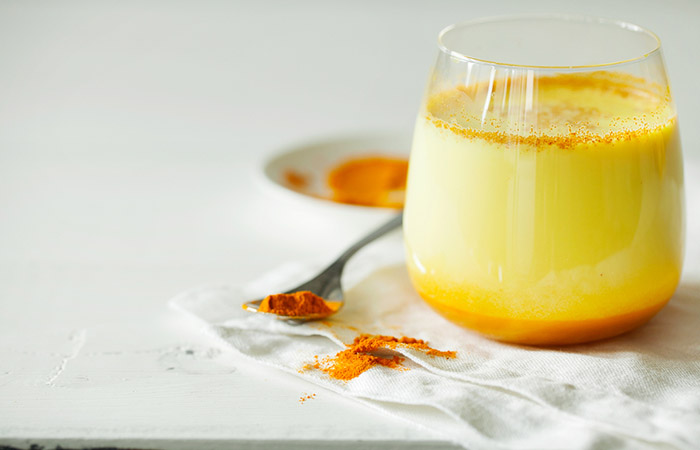
This is the easiest way to consume turmeric and make use of its antibacterial and anti-inflammatory properties.
Ingredients
- A glass of milk
- 1 teaspoon turmeric
Procedure
- Add the turmeric to the milk and bring it to a boil.
- Drink while it is still warm.
How Often You Should Do This
- Drink this every day before going to bed.
You can also add turmeric to your curries, rice, and stews. You may buy turmeric tea and drink it. You can additionally opt for curcumin supplements paired with a healthy and balanced acne diet plan. Although these supplements are taken into consideration safe, unregulated dose of curcumin supplements might cause stomach upsets. Thus, seek advice from a doctor before taking the supplements.
Though turmeric is touted as a skin hero due to its restorative effects and is additionally commonly utilized in Ayurvedic and conventional medicine, it might trigger some negative effects.
Related: 10 Turmeric Milk Benefits And Side Effects To Know
Fun FactCurcumin is also an antiseptic ( 1 ). Thus, it may help keep the skin clean and prevent bacterial acne.
Side Effects Of Using Turmeric For Acne

Turmeric may cause:
1. Allergic Reactions And Contact Dermatitis
Curcumin has anti-inflammatory properties, but it is an allergen i X A safe substance or antigen that is capable of setting off an allergic or unusual immune feedback. It might trigger hypersensitivity i X An inappropriate reaction or immunologic response occurring in response to an allergen or antigen. and allergic reactions ( 14 ). Before making use of turmeric, do a spot examination to check if you dislike it. If you are taking supplements, get an allergic reaction test done ahead of time.
2. It Can Cause Skin Staining
Turmeric has a deep shade of yellow (close to orange), which is why it is likewise made use of as a natural color for fabric. Utilizing turmeric may leave a yellow-colored tarnish on your skin, nails, clothing, and tools. Nevertheless, it vanishes after 2 or 3 cleans.
Although turmeric has actually earned a good online reputation for its recovery effects and there are studies verifying the effectiveness of turmeric extract for acne, none of these studies are conclusive as a lot of them have been done on animals. More human studies are called for to develop the efficiency of turmeric in treating acne and acnes.
Additionally, turmeric is an irritant. For this reason, workout care. Speak with your doctor to understand if your skin can tolerate turmeric or the various other ingredients in the face packs discussed above.
Related: 19 Health Benefits Of Turmeric, How To Use It, & Side Effects
Infographic: Skincare Tips For Acne
Turmeric is a preferred spice utilized for its medical buildings. Its antibacterial and anti-inflammatory residential properties make it excellent for treating acne. While you can use turmeric as a topical treatment, there are a couple of skincare tips you ought to remember when handling acne.
Check out the infographic below to know more.
Illustration: StyleCraze Design Team
Get the high-quality PDF version of this infographic.
Turmeric is an extensively utilized flavor in conventional medicines. The healing results and anti-inflammatory buildings of turmeric make it an outstanding selection to recover skin care issues. Using turmeric for acne is a common do it yourself solution for acne management and skin recovery. The advantages of using turmeric consist of decreasing inflammatory acne, inhibiting the development of acne-causing bacteria, lessening the appearance of dark places, and protecting your skin from UV damage. The tips pointed out over and instructions will certainly aid you know just how to utilize turmeric for acne management.
Frequently Asked Questions
How much turmeric to take daily for acne?
If you are taking supplements, consult a doctor for the right dosage.
How long will it take for turmeric to work for acne?
Any natural remedy takes at least a month to show results.
Is it safe to use turmeric on popped pimples?
You can use it if you are not allergic to it or if it doesn’t irritate the skin.
Are there any risks of an allergic reaction to curcumin?
Yes, it might cause contact dermatitis.
Can we apply turmeric on pimples overnight?
Yes, you can apply turmeric extract on acnes overnight. Yet it is necessary to proceed with caution as applying turmeric extract for an extended period of time can stain your skin yellow. Too much exposure might also trigger even more acne.
Why does turmeric burn your face?
Curcumin is a component of turmeric that may sometimes cause an allergic reaction. Straight skin call can shed, irritate, redden, and create swelling ( 15 ).
Key Takeaways
- Turmeric may help treat acne and other skin-related issues.
- It may help fade dark spots and treat acne scars caused by stubborn acne.
- Turmeric mixed with honey, and neem leaves may help reduce pimples.
- Turmeric mixed with aloe vera gel or olive oil may keep your skin healthy.
- Overuse of turmeric may lead to skin irritation and discoloration.
Discover how to treat pimples and acne with turmeric powder. Discover an all-natural, very easy, and effective method to remove acne and get clear skin with this video clip.



